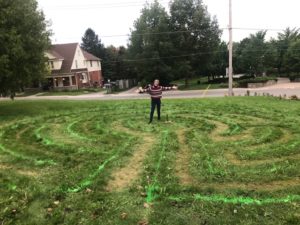
We now have a prayer labyrinth on the lawn outside St. John’s that is open to you and to everyone in the community!
Labyrinths are designed as paths to walk along as you pray or meditate. Unlike a maze, which requires you to make decisions, a labyrinth provides a path that leads you from the entrance to the center, and then, when you are ready, the same path leads you from the center to the place you began.
Our labyrinth is based on the 13th century labyrinth at Chartes Cathedral, France. During the 13th century, for those who could not undertake long pilgrimages to distant places, churches provided labyrinths as a form of pilgrimage for people in their own local area, in the midst of their daily life. Following the example of a labyrinth I saw at the Jesuit Ignatian Retreat Centre in Guelph, our labyrinth is made entirely out of grass, with the grass along the path trimmed shorter than the grass along the borders. You can see the attached pictures of Cathie, Williette, and I mapping out the labyrinth with spray paint (similar to the one we made here in July 2019) and then trimming the grass along the path to make it more visible and longer-lasting.
Here are some suggestions for walking a labyrinth (from the labyrinth at Christ Church Anglican Cathedral, Ottawa)
Approaching the Labyrinth
Follow the path, one step at a time. Make a prayerful preparation. Stand at the entrance, breathe deeply a few times, relax, and still your mind….Take your time. Find your pace. Coordinate your footsteps with your breathing if that helps.
Let go of any expectations you may hold, and observe your experience as it unfolds.
You could ask yourself at each turn, “What am I turning away from in my life? What am I turning towards?”
You could ask for guidance and insight into a concern of your own, or on behalf of someone else.
You could pose a question at the outset.
You could fill your mind with prayer, or sing quietly to yourself.
The labyrinth works at the intuitive “soul level” of the mind: Everything that happens is a metaphor, symbol of something beyond. Remain open to receive subtle images, thoughts, memories, or flashes of insight. These can be fleeting, so it helps sometimes to take paper and pen with you to capture them, and give yourself time after to journal or draw. If you wish to walk in again, feel free to do so.
Three Stages for the Walk
Release: Release and let go as you are walking towards the centre. Release and let go of the details of your life. This is an act of invitation and it quiets and empties the mind. All pilgrimages begin with a first step. It’s the act of walking that makes you a pilgrim, in life or in the labyrinth.
Receive: Open your mind and heart. Let yourself experience the changes of direction. You may get turned around, but you are never lost; trust that the path will lead you where you need to go. When you reach the centre, stay there as long as you like. It is a place of meditation and prayer. Receive what there is for you to receive. Relax and let the wisdom of the world come to you.
Respond: As you leave the centre and return on the same path, ponder what you have received. Take these thoughts back out into the world in which you live. Each time you walk the labyrinth, you become more empowered to find and do the work you feel called to do and to fully be the person you are.
Release: Release and let go as you are walking towards the centre. Release and let go of the details of your life. This is an act of invitation and it quiets and empties the mind. All pilgrimages begin with a first step. It’s the act of walking that makes you a pilgrim, in life or in the labyrinth.
Receive: Open your mind and heart. Let yourself experience the changes of direction. You may get turned around, but you are never lost; trust that the path will lead you where you need to go. When you reach the centre, stay there as long as you like. It is a place of meditation and prayer. Receive what there is for you to receive. Relax and let the wisdom of the world come to you.
Respond: As you leave the centre and return on the same path, ponder what you have received. Take these thoughts back out into the world in which you live. Each time you walk the labyrinth, you become more empowered to find and do the work you feel called to do and to fully be the person you are.
We will be glad to hear of your responses as you walk and pray along the labyrinth. Please feel free to forward this email to any friends or neighbours who might be interested.
Grace and peace,
Lucia
